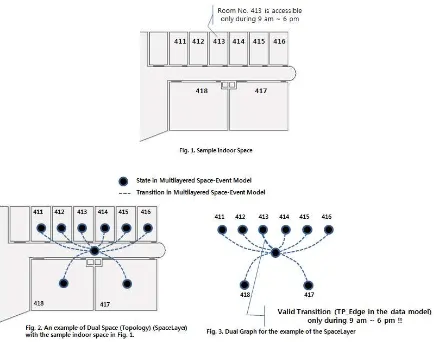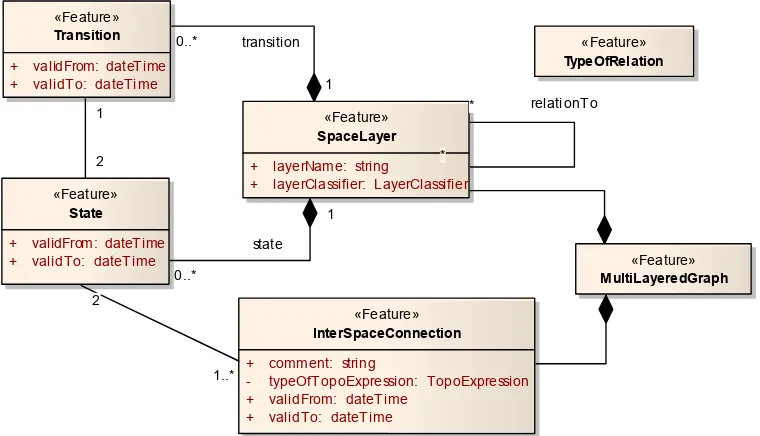All Fields marked with * are mandatory.
Change Request
#:
171
Assigned OGC
Document #:
11-149
Name:
*JaeJun Yoo
Organization:
*ETRI
Email:
*[email protected]
Document
Name/Version:
*Requirements and Space-Event Modeling for Indoor Navigation / 0.1.0
OGC Project
Document:
*10-191r1
If this is a revision of a previous submission and you have a Change Request Number, then check here:
Enter the CR number here:
170
Enter the Revsion Number that you are revising here:
1
Title:
*Temporal Constraints for State and Transition UML class in the data model
Source:
*JaeJun Yoo (OGC member, 3DIM WG, etc)
Work item code:
Category:
*
C (Functional modification of feature)
Reason for
change:
*
When modeling indoor spaces for some indoor services such as
indoor-navigation, we need to consider some temporal constraints when can affect the indoor space model.
For an example and more detailed comments, please refer the uploaded file at supporting document field below.
Summary of
change:
*
please refer the uploaded file at supporting document field below
Consequences if
not approved:
Clauses affected:
*
chapter 8 and chapter 10.
Additional
Documents
affected:
Supporting
Documentation:
Comments:
This change request is a revised version of previously submission. The focus is unchanged. some sentences and figures are fixed.Status:
Assigned
Assigned To:
3DIM DWG
Disposition:
Referred and Posted
1. Reason for change
When we model indoor spaces for location-based services such as indoor-navigation, we need to consider some temporal constraints which can affect the indoor space routing.
For example, let’s suppose room No. 413 is accessible only during the working hours from 9 AM to 6 PM as shown in Fig. 1. If each room and hallway are modeled as a state (TP_Node in the suggested data model) and the walkable path (including doors) between two of them is modeled as a transition (TP_Edge in the suggested data model), then the graph of the modeled space (dual graph) will look like the figure as shown in Fig. 2 and Fig. 3. It means that the transition (TP_Edge) path to room 413 is valid only during 9 AM ~ 6 PM. This kind of temporal constraint can be applied to transitions, that is, joint edges, between the different SpaceLayers.
2. Summary of change
When modeling real indoor spaces, we need to consider ‘temporal constraints’ such as allowed time to access a meeting room or a security room. Such temporal constraints are very common in indoor environment; therefore, it is proposed to include the temporal constraints into the data model of the multilayered space-event model (in Fig. 4 and also refer to Fig. 28 in the discussion paper).
That is, we need to add new methods describing temporal relationships of classes or instances of UML classes “State”, “Transition”, or “InterSpaceConnection” according to the some temporal constraints.
There can be several ways to describe some temporal constraints.
1. Add some attributes to “State”, “Transition” or “InterSpaceConnection” UML classes in the data model, like shown in Fig. 4. (as a part of Fig. 28. in the discussion paper)
2. Add a new UML class to describe temporal constraints.
The first method is more simple to describe and can be intuitively understood although SpaceLayer can be complex if there are many temporal constraints in indoor space to be modeled. Moreover, to add a new class of temporal conditions to the model may have totally different concept from to add some attributes – “time” can be another focus point to model indoor space which can make the data model quite complicated.
Therefore, this change request proposes to add some attributes to describe temporal constraints of indoor space model to some classes, such as “Transition”, “State”, and “InterSpaceConnection”, in the currently suggested UML data model. The type of attributes can be dateTime type in GML.
Fig. 4. Addition of attributes for temporal constraints in the UML data model
Definitely, there can be another way to temporal constraints, it will be worth to be discussed. «Feature» TypeOfRelation «Feature»
Transition
+ validFrom: dateTime + validTo: dateTime
«Feature» State
+ validFrom: dateTime + validTo: dateTime
«Feature» InterSpaceConnection
+ comment: string
- typeOfTopoExpression: TopoExpression + validFrom: dateTime
+ validTo: dateTime «Feature» SpaceLayer
+ layerName: string
+ layerClassifier: LayerClassifier

